Have you ever heard the heartwarming, yet tear-jerking, story of Hachiko? If you’ve delved into the world of Japanese culture or best dog story movies, chances are this legendary Akita dog has touched your heart. Hachiko isn’t just a national hero in Japan; his tale of unwavering loyalty has transcended borders, inspiring books, multiple films, and even iconic statues that draw visitors from around the globe. His story is the epitome of a Japanese Loyal Dog Movie, demonstrating the profound bond between humans and their canine companions.
This incredible true story has been immortalized in both Japanese and Hollywood cinema, making Hachiko’s name synonymous with fidelity. From his iconic bronze statue outside Shibuya Train Station in Tokyo, where countless admirers gather daily, to a replica in Rhode Island, USA—the filming location for the American adaptation—Hachiko’s presence is felt worldwide. But why is this particular tale so famous? Prepare to discover the amazing, real, and profoundly moving narrative of Hachiko, the loyal dog whose memory continues to inspire generations.
Hachiko: The Unforgettable True Story of Loyalty
The true story of Hachiko begins in the early 20th century, a tale that has captivated audiences and become the basis for the most famous japanese loyal dog movie.
From Odate to Shibuya: Hachiko’s Early Life
Born on November 10, 1923, on a farm in Odate City, Akita prefecture, Japan, Hachiko was a purebred Akita dog. His father, Oshinai, and mother, Goma, were both Akitas from the region. Professor Hidesaburō Ueno, an agricultural science professor at The University of Tokyo, had long sought a purebred Akita puppy. After a student’s recommendation, he purchased Hachiko for ¥30, a significant sum at the time, and the young puppy began a grueling 20-hour train journey to Tokyo.
Upon his arrival on January 15, 1924, the tiny puppy was in such poor health that he was initially thought to be dead. However, with the dedicated care of Professor Ueno and his girlfriend, Yae, Hachiko was nursed back to health over the next six months, blossoming into a strong and healthy dog. Professor Ueno affectionately named his new companion “Hachi,” meaning “eight” in Japanese—a number considered lucky in Japan.
An Unbreakable Bond with Professor Ueno
Hachi and his new owner quickly formed an extraordinary bond. Professor Ueno cherished Hachi like a son, and the two became inseparable. Every morning, Hachi would accompany the professor to Shibuya Train Station, seeing him off to work. In the afternoon, with unwavering anticipation, Hachi would return to the station to greet Professor Ueno on his way home. This daily ritual became a cherished routine, a testament to their deep affection.
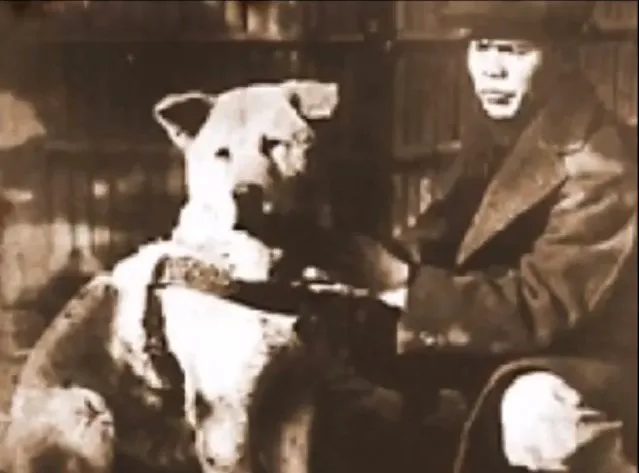 Hachiko with his loving owner, Professor Ueno, capturing the essence of the Japanese loyal dog story
Hachiko with his loving owner, Professor Ueno, capturing the essence of the Japanese loyal dog story
The Faithful Wait Begins
Tragically, on May 21, 1925, just over a year after Hachi had joined his family, Professor Ueno suffered a cerebral hemorrhage and died suddenly at work at the age of 53. Hachi, as usual, waited at Shibuya Station that afternoon, but his beloved owner never appeared.
Despite being adopted by Kozaburo Kobayashi, Professor Ueno’s former gardener, Hachiko never forgot his master. For the next ten years, every single afternoon, Hachiko would go to Shibuya Train Station, arriving precisely when Professor Ueno’s train was due. He would sit there for hours, patiently scanning the faces of disembarking passengers, hoping against hope for the return of his friend who would never come back. This incredible display of devotion is central to what makes the story of Hachiko resonate as a truly profound japanese loyal dog movie.
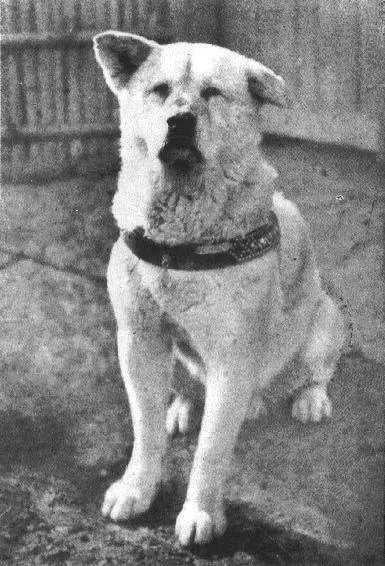 Hachiko, a magnificent purebred Akita dog, whose loyalty became legendary
Hachiko, a magnificent purebred Akita dog, whose loyalty became legendary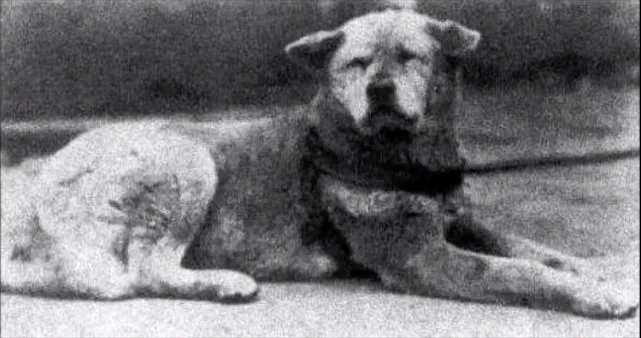 Hachiko patiently waiting at Shibuya Station, a scene synonymous with the loyal Japanese dog movie
Hachiko patiently waiting at Shibuya Station, a scene synonymous with the loyal Japanese dog movie
Initially, Hachiko was not always treated kindly by passersby or station staff, who were unaware of his poignant daily vigil. Stories exist of him being mistreated by some. However, his fortunes changed dramatically when his story was picked up by a local newspaper.
A National Symbol: Hachiko’s Legacy
In 1932, a major Japanese newspaper reporter discovered Hachiko’s incredible story and published it. Overnight, Hachi became a national celebrity, affectionately nicknamed “Chuken-Hachiko,” meaning “Hachiko – the faithful dog.” His tale of unwavering dedication inspired people across Japan and around the world, drawing visitors to Shibuya Station who wished to witness Hachiko’s fidelity and offer him treats.
Hachiko continued his daily routine for an astonishing nine years, nine months, and 15 days, until he peacefully passed away on March 8, 1935, near Shibuya Station at the age of 11. Even today, Hachiko remains a powerful symbol of love, devotion, and loyalty, his story serving as a timeless reminder of the special bond between dogs and humans. His legacy is why many search for a japanese loyal dog movie to experience this deep connection.
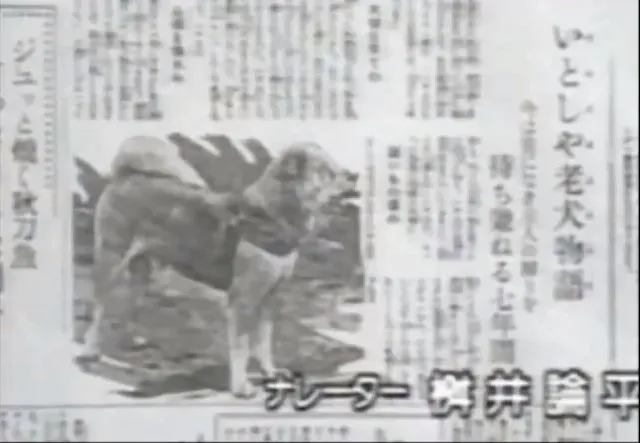 Historic Japanese newspaper clipping featuring Hachiko, the faithful Akita, and his remarkable story
Historic Japanese newspaper clipping featuring Hachiko, the faithful Akita, and his remarkable story
The Japanese Loyal Dog Movie Phenomenon
The profound story of Hachiko’s loyalty was destined for the big screen, cementing its place as a quintessential japanese loyal dog movie experience for audiences worldwide.
The Original Japanese Film: Hachiko Monogatari (1987)
The first cinematic adaptation of Hachiko’s story was the 1987 Japanese film, Hachiko Monogatari. This powerful movie brought the emotional true story to life for a new generation in Japan, capturing the essence of Professor Ueno and Hachiko’s relationship, and the dog’s decade-long vigil. The film was a critical and commercial success, solidifying Hachiko’s status as a cultural icon and further spreading his tale of devotion. For those interested in the raw, original portrayal of this narrative, Hachiko Monogatari is essential viewing, offering a deep dive into hachiko the story of a loyal dog.
Hollywood’s Rendition: Hachi: A Dog’s Tale (2009)
In 2009, Hollywood produced its own version, Hachi: A Dog’s Tale, starring Richard Gere as Professor Parker Wilson (the Americanized equivalent of Professor Ueno). This adaptation brought Hachiko’s story to a global English-speaking audience, set in a contemporary American context. Filmed primarily in Rhode Island, the movie sensitively portrayed the unbreakable bond and the enduring wait, becoming widely recognized as the japanese loyal dog movie for many Western viewers. A replica of the Shibuya statue stands in Woonsocket Depot Square, Rhode Island, marking the filming location’s “Bedridge” train station. The success of this film further underscored the universal appeal of Hachiko’s narrative. Those seeking out an akita dog movie with richard gere will find this adaptation particularly moving.
Why These Movies Resonate
Both Hachiko Monogatari and Hachi: A Dog’s Tale have resonated deeply with audiences because they tap into universal themes: unconditional love, unwavering loyalty, loss, and hope. They serve as powerful reminders of the incredible capacity for love that animals possess and the profound impact they have on our lives. Watching either of these films is an emotional journey, often prompting tears, but always leaving viewers with a lasting impression of Hachiko’s extraordinary spirit. If you’re looking for hachiko a true story of a loyal dog captured on film, these adaptations deliver.
Experiencing Hachiko’s Legacy in Japan
For many, the story of Hachiko is not just a film or a book; it’s a pilgrimage. Japan offers several poignant sites where you can connect with the legend of this remarkable dog.
Iconic Hachiko Statues: Shibuya and Beyond
Across Tokyo, Hachiko’s memory is honored through various statues and monuments, each telling a part of his story.
Shibuya Station Statue
The most famous Hachiko statue stands proudly in front of Shibuya Station. Erected in 1934 by Japanese artist Teru Andō, Hachiko himself was present at its grand unveiling. This bronze statue quickly became one of Tokyo’s most popular tourist attractions and a beloved meeting point, especially among young Japanese. The original statue was melted down for metal during World War II, but a new one, crafted by Takeshi Ando (the original artist’s son), was erected in 1948. Today, the station exit facing the statue is famously known as “Hachikō-guchi,” or “The Hachikō Entrance/Exit.”
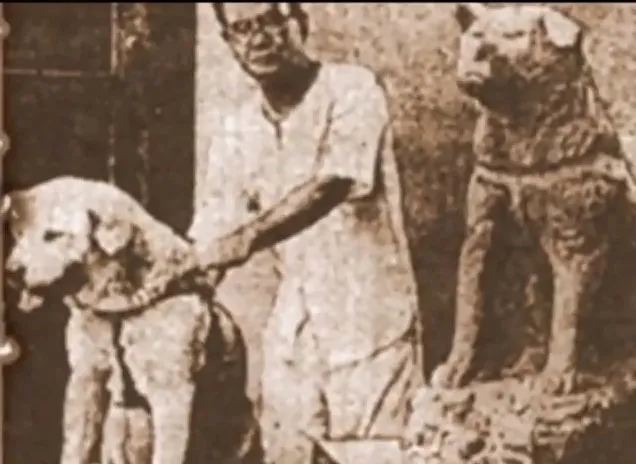 The original Hachiko statue at Shibuya Station, unveiled with the loyal Japanese dog himself present
The original Hachiko statue at Shibuya Station, unveiled with the loyal Japanese dog himself present![]() Crowds gathering around the iconic Hachiko bronze statue at Shibuya Station, a popular Tokyo landmark
Crowds gathering around the iconic Hachiko bronze statue at Shibuya Station, a popular Tokyo landmark
Each year, on March 8th, the anniversary of Hachiko’s passing, a memorial ceremony is held at Shibuya Station, honoring his unwavering love and loyalty. The 2023 ceremony was particularly significant, marking what would have been Hachiko’s 100th birthday.
Hachiko Mosaic – Shibuya Station
On a wall within Shibuya Station, you’ll find a magnificent mosaic artwork titled “Hachiko Family.” Created by Japanese artist Ryutaro Kitahara and completed in March 1990, this mural depicts a joyful Hachiko playing with his parents and siblings. It’s a beautiful, colorful tribute that adds another layer to the story of hachiko the loyal dog.
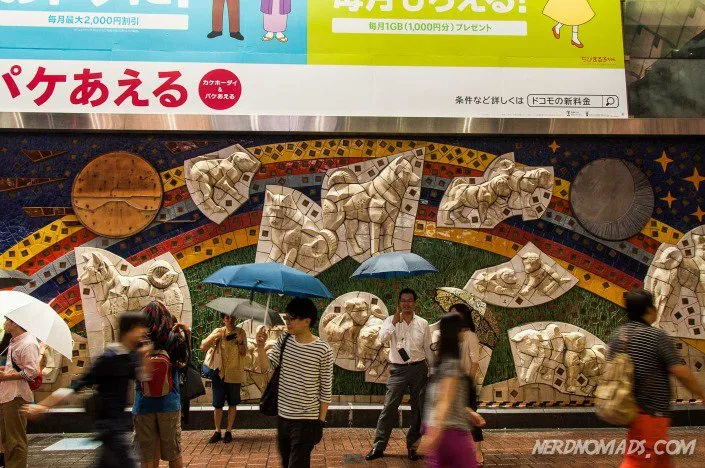 Beautiful Hachiko Family mosaic mural adorning a wall at Shibuya Station, depicting the Akita dog's joyful family
Beautiful Hachiko Family mosaic mural adorning a wall at Shibuya Station, depicting the Akita dog's joyful family
Stuffed Hachiko – National Museum of Nature and Science, Tokyo
After his peaceful passing on March 8, 1935, Hachiko’s immense symbolic importance led to him being preserved. Today, you can visit and respectfully observe the taxidermied Hachiko at the National Museum of Nature and Science in Ueno, Tokyo, a profound way to connect with the physical legacy of this loyal canine.
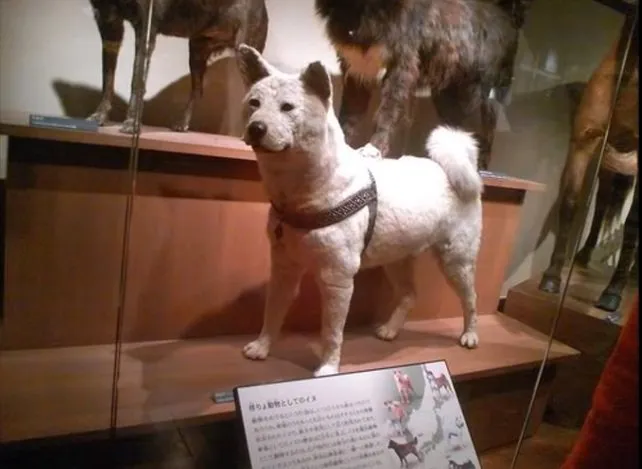 The preserved remains of Hachiko on display at the National Museum of Nature and Science in Ueno, Tokyo
The preserved remains of Hachiko on display at the National Museum of Nature and Science in Ueno, Tokyo
Hachiko & Professor Ueno Statue – University of Tokyo
Perhaps the most heartwarming of all monuments is the bronze statue at the University of Tokyo, depicting a joyous reunion between Hachiko and Professor Hidesaburō Ueno. This statue, erected on March 9, 2015, on the 80th anniversary of Hachiko’s death, shows Hachiko leaping to greet his master at the end of a workday. It’s a poignant portrayal of their bond, offering a moment of peaceful reflection away from the bustling crowds of Shibuya. A small museum nearby displays articles, photos, and even Hachiko’s autopsy report, which revealed he died of terminal cancer and a filaria infection.
Hachiko Monument – Professor Ueno’s Grave
While Hachiko’s fur was preserved for the museum, his remains were cremated, and his ashes were laid to rest beside his beloved Professor Ueno. You can visit his monument at Professor Ueno’s grave in Aoyama Cemetery in Minato, Tokyo, a final testament to their eternal bond.
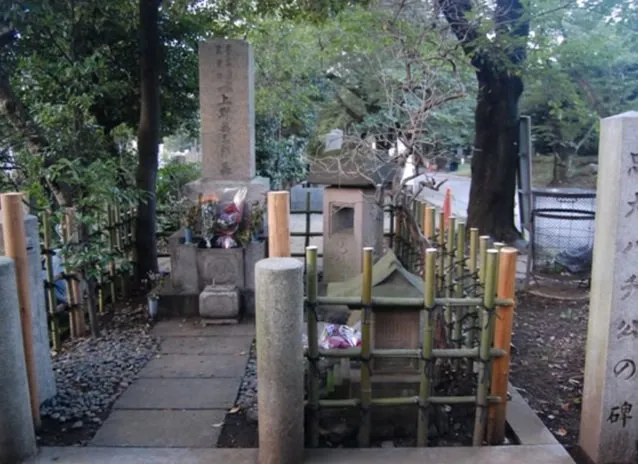 Hachiko's monument resting beside Professor Ueno's tomb in Aoyama Cemetery, symbolizing eternal loyalty
Hachiko's monument resting beside Professor Ueno's tomb in Aoyama Cemetery, symbolizing eternal loyalty
The Akita Hachiko Dog Museum in Odate City
For animal lovers and Akita enthusiasts, a visit to the Akita Hachiko Dog Museum in Odate City, Akita prefecture, is a must. This museum celebrates the most famous Akita dog in the world, Hachiko, and provides extensive information about the Akita breed. On weekdays, visitors can even meet and interact with live Akita dogs, an especially delightful experience. Odate City, the “capital city” of the Akita breed, is adorned with Hachiko statues and symbols, from the train station to manhole covers. The museum is open daily from mid-April to mid-November.
Beyond the Movies: Books and Merchandise
The enduring appeal of Hachiko extends beyond the big screen. Numerous books have been written about Hachiko and his incredible life, offering deeper insights into the historical context and emotional impact of his story. These literary works complement the visual experience of the japanese loyal dog movie adaptations, providing another avenue for appreciating Hachiko’s legacy. Furthermore, Hachiko-themed merchandise, such as adorable Akita teddies, allows fans to carry a piece of this touching story with them.
Planning Your Hachiko Pilgrimage to Tokyo
If the story of Hachiko and the japanese loyal dog movie adaptations have inspired you, a visit to Tokyo offers a unique opportunity to walk in Hachiko’s paw prints. Make sure to include the Shibuya Station statue, the monument at Professor Ueno’s tomb in Aoyama cemetery, and the preserved Hachiko at the National Museum of Nature and Science in Ueno on your itinerary.
Where to Stay in Tokyo for Hachiko Fans
Tokyo boasts an incredible array of accommodations to suit every budget and preference, from luxurious hotels to traditional Japanese inns and unique capsule hotels.
Top Range
- The Park Hyatt: Famously featured in “Lost in Translation,” The Park Hyatt offers unparalleled luxury. Its spacious, elegant rooms provide modern comforts, and its professional service is legendary. The New York Bar Grill, located on the top floor, offers stunning city views.
- Click for latest prices
- Palace Hotel Tokyo: An epitome of luxury with impeccable service and stunning Imperial Palace views.
- The Tokyo Station Hotel: A historic and elegant hotel located within Tokyo Station itself, offering convenience and classic charm.
Mid-Range
- Tokyu Stay Shinjuku: This hotel boasts a prime location near Shinjuku-sanchome station. Bright, modern rooms include thoughtful amenities like a microwave and washing machine, offering great value in a bustling area.
- Click for latest prices
- Hotel MyStays Asakusabashi: A newer hotel with decent-sized rooms for Japan, located in a vibrant neighborhood with plenty of dining options and easy subway access.
- Click for latest prices
Budget
- MyCube by MyStays: For solo travelers on a budget or those seeking the unique Tokyo capsule hotel experience, MyCube offers new, spacious pods with lockable storage and free Wi-Fi, conveniently located next to a subway station.
- Click for latest prices
- Khaosan Asakusa Hostel: A popular choice for budget-conscious travelers, offering a social atmosphere and good access to attractions.
Tokyo offers numerous accommodation options across its diverse neighborhoods. Choosing the right area can enhance your visit, especially if you plan to explore Hachiko’s memorials.
Conclusion
The story of Hachiko is more than just a historical anecdote; it’s a timeless testament to the extraordinary capacity for loyalty and love within the animal kingdom. His life, his unwavering wait, and his enduring legacy have inspired millions through books and, most notably, through the moving adaptations of the japanese loyal dog movie. Whether you’ve seen the original Japanese Hachiko Monogatari or the Hollywood rendition Hachi: A Dog’s Tale, the emotional impact is undeniable. Hachiko reminds us that dogs truly are man’s best friend, capable of forming bonds that transcend life itself. His story continues to be a beacon of devotion, prompting us to cherish our own furry companions and reflect on the profound connections we share.
References
- Itoh, Mayumi. Hachikō: The True Story of the Royal Dog of Japan That Inspired the Movie Hachi. 2017.
- Wikipedia – Hidesaburō Ueno.
- National Museum of Nature and Science, Tokyo.
- The Akita Inu Hozonkai (Akita Dog Preservation Society).
